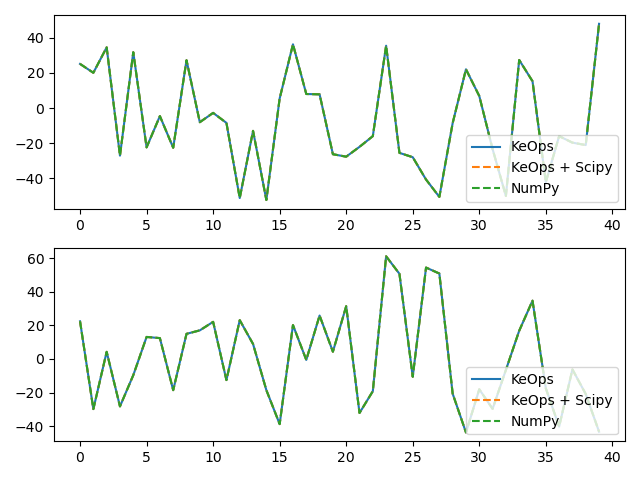Note
Go to the end to download the full example code
KernelSolve reduction (with LazyTensors)
Let’s see how to solve discrete deconvolution problems
using the conjugate gradient solver provided by
the pykeops.numpy.LazyTensor.solve() method of KeOps pykeops.numpy.LazyTensor.
Setup
Standard imports:
import time
import matplotlib.pyplot as plt
import numpy as np
from pykeops.numpy import Vi, Vj, Pm
import pykeops.config
Define our dataset:
N = 5000 if pykeops.config.gpu_available else 500 # Number of points
D = 2 # Dimension of the ambient space
Dv = 2 # Dimension of the vectors (= number of linear problems to solve)
sigma = 0.1 # Radius of our RBF kernel
x = np.random.rand(N, D)
b = np.random.rand(N, Dv)
g = np.array([0.5 / sigma**2]) # Parameter of the Gaussian RBF kernel
alpha = 0.01
KeOps internal conjugate gradient solver
print("Solving a Gaussian linear system, with {} points in dimension {}.".format(N, D))
start = time.time()
Kxx = (-Pm(g) * Vi(x).sqdist(Vj(x))).exp()
c = Kxx.solve(Vi(b), alpha=alpha)
end = time.time()
print("Timing (KeOps implementation):", round(end - start, 5), "s")
Solving a Gaussian linear system, with 5000 points in dimension 2.
Timing (KeOps implementation): 3.91066 s
Note
The pykeops.numpy.LazyTensor.solve() method uses a conjugate gradient solver and assumes
that Kxx defines a symmetric, positive and definite
linear reduction with respect to the alias "b"
specified trough the third argument.
Apply our solver on arbitrary point clouds:
Scipy conjugate gradient
from scipy.sparse import diags
from scipy.sparse.linalg import aslinearoperator, cg
print("Solving a Gaussian linear system, with {} points in dimension {}.".format(N, D))
start = time.time()
A = aslinearoperator(diags(alpha * np.ones(N))) + aslinearoperator(Kxx)
c_sp = np.zeros((N, Dv))
for i in range(Dv):
c_sp[:, i] = cg(A, b[:, i])[0]
end = time.time()
print("Timing (KeOps + scipy implementation):", round(end - start, 5), "s")
Solving a Gaussian linear system, with 5000 points in dimension 2.
Timing (KeOps + scipy implementation): 6.76095 s
Compare with a straightforward Numpy implementation:
start = time.time()
K_xx = alpha * np.eye(N) + np.exp(
-g * np.sum((x[:, None, :] - x[None, :, :]) ** 2, axis=2)
)
c_np = np.linalg.solve(K_xx, b)
end = time.time()
print("Timing (Numpy implementation):", round(end - start, 5), "s")
print("Relative error (KeOps) = ", np.linalg.norm(c - c_np) / np.linalg.norm(c))
print("Relative error (KeOps + scipy)= ", np.linalg.norm(c - c_sp) / np.linalg.norm(c))
# Plot the results next to each other:
for i in range(Dv):
plt.subplot(Dv, 1, i + 1)
plt.plot(c[:40, i], "-", label="KeOps")
plt.plot(c_sp[:40, i], "--", label="KeOps + Scipy")
plt.plot(c_np[:40, i], "--", label="NumPy")
plt.legend(loc="lower right")
plt.tight_layout()
plt.show()

Timing (Numpy implementation): 0.92197 s
Relative error (KeOps) = 4.743432664518057e-07
Relative error (KeOps + scipy)= 2.571710016355496e-06
Total running time of the script: (0 minutes 11.732 seconds)